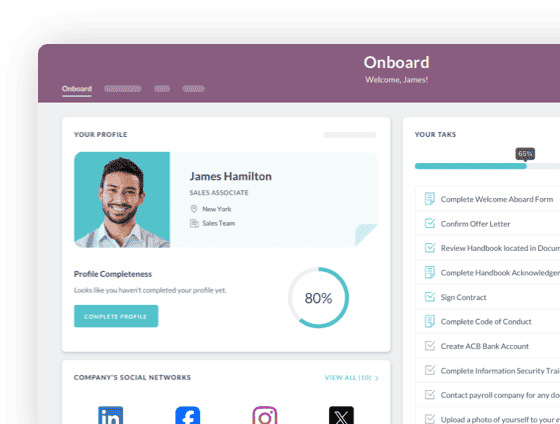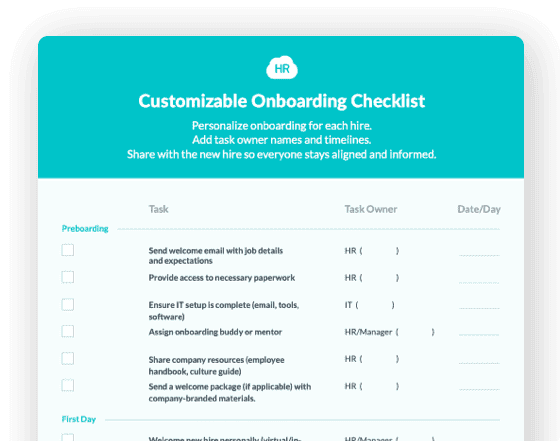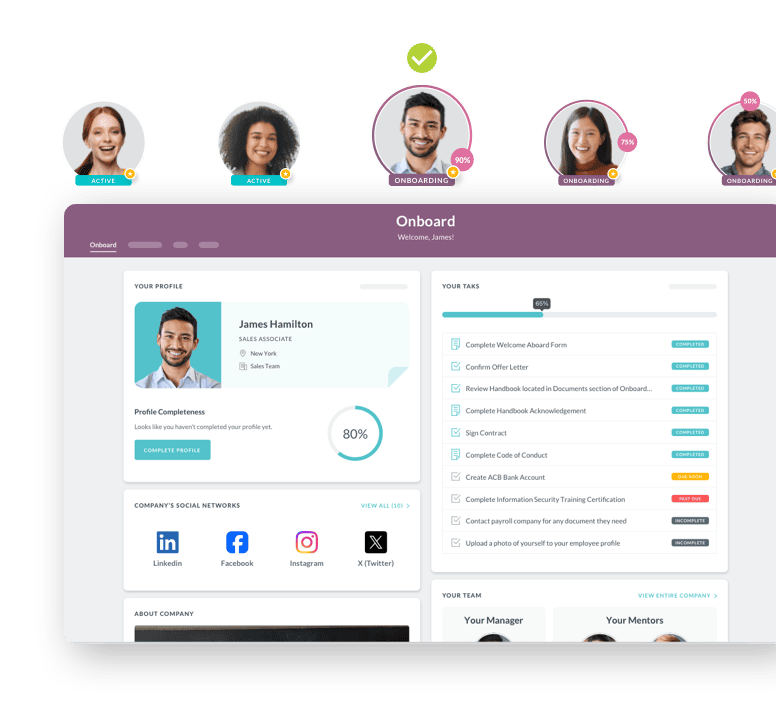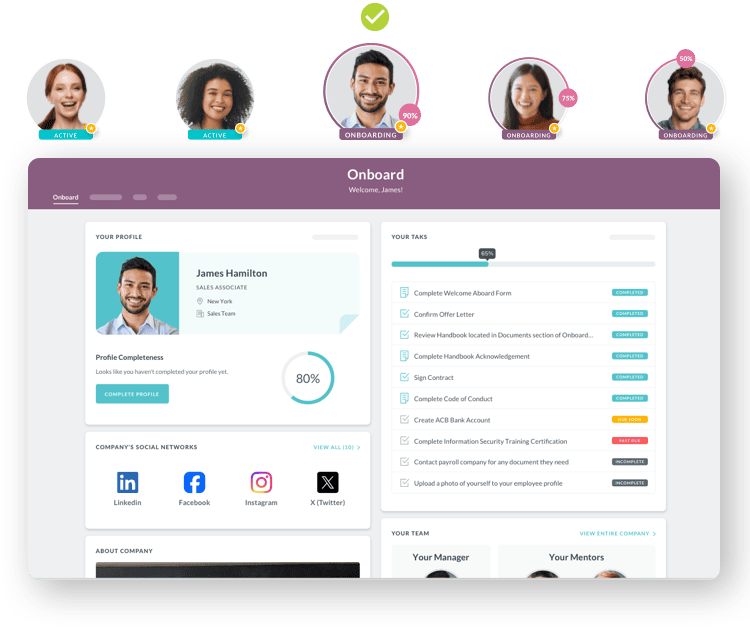HR Compliance

 Cut onboarding time
by 60%—here's the
Ultimate Checklist
that helped do it.
Cut onboarding time
by 60%—here's the
Ultimate Checklist
that helped do it.

What Is HR Compliance and Why It Matters for Your Business
HR compliance means following all the rules, laws, and regulations about employees. These rules cover everything from hiring to paying people, managing their work, and handling when they leave. For business leaders, it's not just about following the law. It's also about protecting your company, building a strong and ethical culture, and creating a fair and productive workplace. Ignoring these laws can lead to big financial penalties, legal action, and a damaged reputation. When you take a proactive approach to compliance, you can avoid these risks and focus on your business goals.
The modern workplace is more complex than ever. New regulations are always appearing at the local, state, and federal levels. For example, laws about remote work, data privacy, and using artificial intelligence in hiring are always changing. A strong foundation in HR compliance helps your company adapt to these changes without problems. It also shows your employees that you care about their well-being and treat them with respect. This can boost employee morale and help you keep good people. For more on how to manage these requirements, you can learn about a complete human resources solution that helps streamline your compliance efforts.
Key Areas of HR Compliance for Any Business
Effective HR compliance involves many different areas. Each one is important to make sure your business operates legally and ethically.
Equal Employment Opportunity (EEO):
This protects employees from discrimination and harassment. It is based on things like race, color, religion, sex, national origin, age, and disability. EEO laws require fair hiring practices and a workplace with no harassment.
Wage and Hour Laws:
Rules like the Fair Labor Standards Act (FLSA) manage minimum wage, overtime pay, and record-keeping. It is a common and expensive mistake to misclassify an employee as being exempt from overtime when they are not.
Health and Safety:
The Occupational Safety and Health Administration (OSHA) sets standards to make workplaces safe and healthy for all workers. This includes providing protective equipment and training.
Employee Leave and Benefits:
Laws like the Family and Medical Leave Act (FMLA) require employers to provide job-protected leave for certain family and medical reasons. Understanding and administering benefits correctly is also a key part of compliance. You can see how a robust benefits administration platform can help manage this complexity.
Workers' Compensation and Unemployment:
Employers must contribute to state-run insurance programs. These programs give benefits to employees who are injured on the job or lose their job without it being their fault.
Privacy and Data Protection:
Laws like the California Consumer Privacy Act (CCPA) regulate how businesses collect, use, and store employee data. Protecting this sensitive information is a growing concern for all businesses. Understanding how to manage employee documents is crucial for maintaining privacy and compliance.
Best Practices for Maintaining HR Compliance
Building a culture of compliance is not a one-time task. It needs constant attention and strategic effort. By using these best practices, you can create a resilient system that protects your business.
Develop and Maintain Clear Policies.
Have a full employee handbook that explains all company policies and procedures. This handbook should cover everything from anti-harassment policies to leave requests and the code of conduct. Make sure to review and update it often.
Conduct Regular Audits.
Periodically review your HR practices to make sure they follow current laws. An audit can help you find issues with wage and hour classifications, documentation, or hiring practices before they become a problem. HR software solutions can assist in managing these audits efficiently.
Prioritize Employee Training.
All employees, especially managers, should receive training on key compliance topics. These include harassment prevention, workplace safety, and data privacy. This training helps make sure everyone understands their responsibilities and the company's expectations. SHRM, a leading HR organization, provides extensive resources on this topic.
Stay Informed on Legal Changes.
Laws about employment change frequently. Assign someone on your team or use a legal service to stay updated on new and changing federal, state, and local regulations. This is especially important for businesses that operate in multiple states.
Pitfalls to Avoid in HR Compliance
Even with good intentions, businesses can fall into common traps. Knowing these pitfalls is the first step toward avoiding them.
Ignoring State and Local Laws.
Federal laws are just one part of the puzzle. Many states and cities have their own specific rules on minimum wage, paid leave, and sick time. For example, some cities have their own rules on fair chance hiring that must be followed.
Misclassifying Workers.
The difference between an employee and an independent contractor is critical. Getting it wrong can lead to costly legal challenges.
Inconsistent Record-Keeping.
Not keeping accurate and complete employee records can cause big problems during an audit or legal dispute. Good record-keeping is the foundation of defensible HR practices.
Neglecting the Onboarding Process.
The onboarding process is a critical time for compliance. Failing to complete necessary paperwork, like I-9 forms for employment eligibility and W-4 tax forms, can lead to fines. A solid onboarding software system can automate these tasks. This helps make sure you don't miss anything.


Real-World Industry Applications
HR compliance impacts every industry, from technology to manufacturing. Here are some examples of how it plays out in different business sectors.
Retail and Hospitality:
These industries often hire many part-time and seasonal workers. Compliance challenges include managing flexible schedules, tracking hours for overtime, and making sure minors are working within legal limits. A company in this space must also train many frontline managers. This training should cover how to handle customer and employee incidents in a compliant way.
Technology and Software:
This sector focuses on remote and global teams. This means they face unique compliance issues. Data privacy regulations, such as the General Data Protection Regulation (GDPR) in Europe, are crucial. They matter when handling employee data from different regions. Additionally, managing international payroll and tax laws for remote employees who live in various countries requires careful attention.
Healthcare:
Healthcare organizations must comply with complex regulations. For example, the Health Insurance Portability and Accountability Act (HIPAA) protects patient data. They also have specific rules from OSHA about handling biohazards. For instance, a hospital must ensure all employees have proper training and equipment to prevent the spread of infectious diseases. The World Economic Forum has highlighted the importance of data governance in this sector.
A Step-by-Step Implementation Plan for HR Compliance
For business leaders looking to improve their HR compliance, a structured plan can make the process easier.
Assess Your Current State.
Start with a full review of your existing HR practices. Look at your employee handbook, hiring documents, payroll records, and benefits administration. Find any gaps or areas of risk.
Form a Compliance Team.
This doesn't have to be a big department. It can be a small team or even a single leader who oversees compliance. This person should work closely with legal counsel or a knowledgeable HR consultant. A good human resources information system can provide the data and tools this team needs.
Update and Document Policies.
Based on your assessment, revise or create new policies and procedures. Put everything in writing. Make sure your employee handbook is up-to-date and easy for all employees to access.
Train Your Team.
Roll out training sessions for managers and employees on the updated policies. Use an online learning management system to make this process scalable and easy to track. A recent Forbes article discusses the value of employee training.
Leverage Technology.
Investing in an HR platform can automate many compliance tasks. This can reduce the risk of human error and save your team valuable time. For example, an applicant tracking system can ensure your hiring process remains compliant and fair.
Future Outlook and Trends in HR Compliance
The landscape of HR compliance is always changing. Business leaders must look ahead to prepare for what's next.
One of the most important trends is the growing focus on data privacy and AI. Companies use more technology to hire and manage employees. Because of this, new laws are appearing to protect people's personal information. These laws also ensure that algorithms are not biased. For example, some places are creating rules about how companies can use AI in the hiring process.
Another key area is the rise of the gig economy and remote work. The traditional employee-contractor model is being challenged. New laws are being developed to address the unique needs of gig workers. Remote work has also led to many new challenges. These range from ensuring fair pay across different locations to following the diverse state and local laws where employees live.
Finally, the trend toward social and environmental governance is influencing HR. Businesses face pressure to be more transparent about their diversity and inclusion practices. They also need to be open about their impact on their communities. This moves HR compliance beyond just legal boxes and into the world of ethical business practices. Being proactive in these areas helps you stay ahead of potential regulations. It also helps you attract and keep the best talent. A Gallup study on employee engagement highlights how a strong company culture can be a competitive advantage. The future of HR compliance is about being agile, ethical, and ready to adapt.
Keep Reading
From Manual to Automated: A Complete Guide to Digitizing Employee Onboarding for Large Organizations
Sarah Chen, Director of HR at a 7,000-employee healthcare organization, starts her Monday
Enterprise HR Software in 2025: Why Traditional Enterprise Platforms Fall Short and What Actually Works
Traditional enterprise human resources software systems promise comprehensive solutions
AI in Onboarding: Complete Guide for 2026
You’ve probably been hearing this multiple times a day — AI is transforming HR. But
Ready to streamline your onboarding process?
Book a demo today and see how HR Cloud can help you create an exceptional experience for your new employees.

